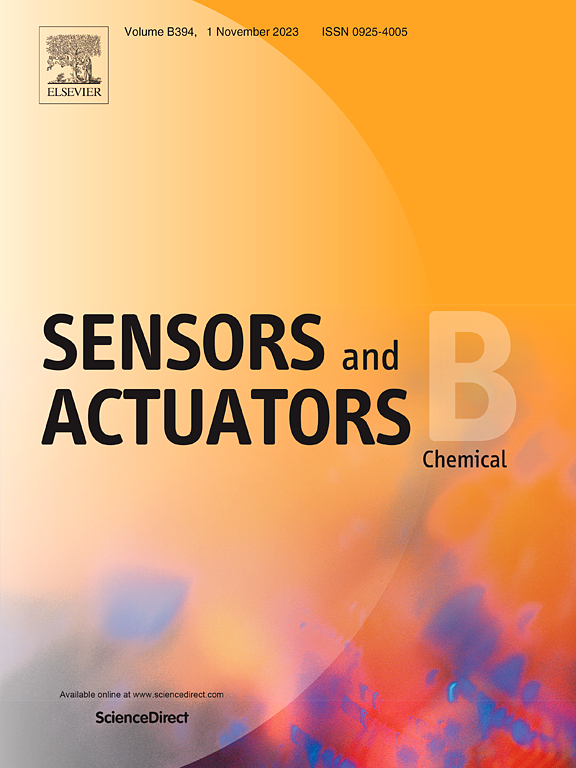分子印迹膜SERS底物的空间生长,用于快速样品制备和灵敏的食品安全分析
IF 8
1区 化学
Q1 CHEMISTRY, ANALYTICAL
引用次数: 0
摘要
快速、准确的检测方法是食品安全分析的迫切要求。开发多功能传感材料,使分子印迹样品制备和表面增强拉曼散射(SERS)检测一体化是一种可能的解决方案。然而,分子印迹聚合物SERS (MIPs-SERS)底物的厚度对分析方法的快速和灵敏度至关重要,因为它既有助于选择性富集,又有助于充分的拉曼信号放大。采用空间限制生长策略在微反应器装置中制备了厚度可控的MIPs-SERS。作为概念验证,制备了两种类型的MIPs-SERS底物,实现了样品制备和SERS检测的一体化。以印迹因子(IFIF)为18.9,拉曼增强因子(EFEF)为8.5×106,制备了Au/MIPs膜,用于白细胞孔雀石绿(LMG)的选择性分离、富集、化学转化和SERS检测。同时,制备了Au/Ag@MIPs膜,其IFIF为10.5,EFEF为2.8×106,用于氯吡脲(CPPU)选择性分离富集和Au/Ag纳米粒子协同SERS检测。基于MIPs-SERS底物,建立了选择性灵敏的分析方法,LMG的检出限为0.49 μg/L, CPPU的检出限为6.8 μg/L,满足食品安全分析要求。在食品安全分析中,分别在鱼和枣样品中检测到LMG和CPPU,并通过回收率试验和标准色谱方法对结果进行验证。这项工作为快速复杂样品分析以及厚度可控的聚合物膜制造策略提供了一种替代方法。本文章由计算机程序翻译,如有差异,请以英文原文为准。

Space-confined growth of molecularly imprinted membrane SERS substrate for rapid sample preparation and sensitive food safety analysis all-in-one
Rapid and accuracy sensing approach is urgent demand in food safety analysis. Development of multifunctional sensing material enabling the integration of molecularly imprinted sample preparation and surface-enhanced Raman scattering (SERS) detection all-in-one is a possible solution. However, the thickness of the molecularly imprinted polymers SERS (MIPs-SERS) substrates is critical to rapidity and sensitivity of analytical method by contributing both the selective enrichment and sufficient Raman signal amplification. A space-confined growth strategy was using for the thickness controllable fabrication of the MIPs-SERS in a microreactor device. As proofs of concept, two types of MIPs-SERS substrates were prepared to realize sample preparation and SERS detection all-in-one. The Au/MIPs membrane was prepared for leucomalachite green (LMG) selective separation, enrichment, chemical conversion and SERS detection with an imprinting factor () of 18.9 and a Raman enhancement factor () of 8.5 × 106. Meanwhile, the Au/Ag@MIPs membrane was prepared for forchlorfenuron (CPPU) selective separation, enrichment and Au/Ag nanoparticles synergistic SERS detection with an of 10.5 and a of 2.8 × 106. Based on the MIPs-SERS substrates, selective and sensitive analytical method were established with the limit of detections of 0.49 μg/L for LMG and 6.8 μg/L for CPPU, which meeting the requirement of food safety analysis. In the food safety analysis, LMG and CPPU were detected in a fish and jujube sample, respectively, and the results were verified by recovery tests and standard chromatographic methods. This work provides an alternative approach for rapid complex sample analysis as well as a thickness controllable polymer membrane fabrication strategy.
求助全文
通过发布文献求助,成功后即可免费获取论文全文。
去求助
来源期刊

Sensors and Actuators B: Chemical
工程技术-电化学
CiteScore
14.60
自引率
11.90%
发文量
1776
审稿时长
3.2 months
期刊介绍:
Sensors & Actuators, B: Chemical is an international journal focused on the research and development of chemical transducers. It covers chemical sensors and biosensors, chemical actuators, and analytical microsystems. The journal is interdisciplinary, aiming to publish original works showcasing substantial advancements beyond the current state of the art in these fields, with practical applicability to solving meaningful analytical problems. Review articles are accepted by invitation from an Editor of the journal.
 求助内容:
求助内容: 应助结果提醒方式:
应助结果提醒方式:


